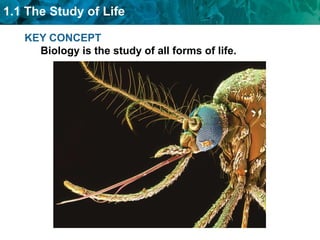Unit 1 Introduction To The Study Of Life
•Download as PPTX, PDF•
4 likes•6,960 views
Report
Share
Report
Share

More Related Content
What's hot
What's hot (20)
Biology - Chp 1 - Biology The Study Of Life - PowerPoint

Biology - Chp 1 - Biology The Study Of Life - PowerPoint
Q1C1L1 Animal and Plant Organ Systems and their Functions (2).pptx

Q1C1L1 Animal and Plant Organ Systems and their Functions (2).pptx
Viewers also liked
Viewers also liked (20)
Unit 16a Resource consumption pollution and greenhouse effect

Unit 16a Resource consumption pollution and greenhouse effect
Unit 14a Relationships, biotic, and abiotic factors

Unit 14a Relationships, biotic, and abiotic factors
Similar to Unit 1 Introduction To The Study Of Life
Similar to Unit 1 Introduction To The Study Of Life (20)
More from Olympus High School - Jeff Taylor
More from Olympus High School - Jeff Taylor (20)
SDS Episode2 - The Habitat Requirements of Pacific Northwest Bats

SDS Episode2 - The Habitat Requirements of Pacific Northwest Bats
Unit 18a DNA fingerprinting and genetic engineering

Unit 18a DNA fingerprinting and genetic engineering
Unit 15a Habitat niche interactions and growth patterns

Unit 15a Habitat niche interactions and growth patterns
Unit 1 Introduction To The Study Of Life
- 1. KEY CONCEPT Biology is the study of all forms of life.
- 2. biosphere = everywhere life exists Earth is home to an incredible diversity of life. The biosphere includes all living things and all the places they are found.
- 3. Earth is home to an incredible diversity of life. Every part of the biosphere is connected with every other part. The biosphere includes many environments. land environments
- 7. All organisms share certain characteristics. Biology is the scientific study of all forms of life.
- 11. All levels of life have systems of related parts. A system is an organized group of interacting parts. A cell is a system of chemicals and processes. A body system includes organs that interact. An ecosystem includes living and nonliving things that interact.
- 12. Biologists study many different systems.
- 13. Structure and function are related in biology. Structure determines function. Proteins with different structures perform different functions. Heart muscle cells have a different structure and function than stomach muscle cells. Different species have different anatomical structures with different functions.
- 14. Organisms must maintain homeostasis to survive in diverse environments. Homeostasis is the maintenance of constant internal conditions.
- 16. Behaviors and adaptations can help maintain homeostasis. Hollow hairs transmit light to the skin and create insulation for cold environments
- 17. Evolution explains the unity and diversity of life. Evolution is the change in living things over time. The genetic makeup of a population of a species changes. Evolution can occur through natural selection of adaptations. Adaptations are beneficial inherited traits that are passed to future generations.
- 18. Evolution accounts for both the diversity and the unity of life.
- 19. KEY CONCEPTScience is a way of thinking, questioning, and gathering evidence.
- 21. Scientists form a hypothesis as a possible answer to a question.
- 23. Experimentals allow scientists to determine what causes a phenomenon.
- 24. Experiments allow scientists to determine what causes a phenomenon. By smelling something other than orange juice, it can affect a person’s sense of taste.
